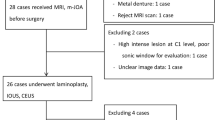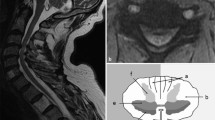Abstract
Purpose
To evaluate cerebrospinal fluid (CSF) flow in cervical compressive myelopathy (CCM), by both quantitative and qualitative analyses, using 3T cine phase-contrast magnetic resonance imaging (cine MRI).
Methods
From September, 2014 to June, 2015, we enrolled 45 subjects (18 women and 27 men, mean age, 61.7 ± 13.4 years) to undergo cervical cine MRI. The subjects were divided into three groups: no stenosis and cervical stenosis with and without intramedullary T2 hyperintensity. We measured maximal CSF velocity, and 12 CSF velocity waveforms were plotted per subject. Two readers independently assessed the CSF waveform shape (0 absent; 1 serrated; 2 bi-directional with small amplitude; and 3 normal bi-directional waveform) and the CSF motion pattern (0 absent; 1 interrupted; and 2 intact). The numbers of 12 waveform shapes were summed to yield a CSF waveform score. Linear mixed model and ROC curve analyses were used for statistical analyses.
Results
Maximal CSF velocity was significantly lower in CCM (marginal mean, 2.72 cm/s) than in stenosis without intramedullary T2 hyperintensity (3.27 cm/s, p = 0.027) and no stenosis (3.80 cm/s, p < 0.001). Bi-phasic CSF motion was lost in cervical stenosis. CSF waveform scores of 17 (area under curve (AUC), 0.797; p = 0.003) and 16.5 (AUC, 0.790; p = 0.004) could predict Japanese Orthopedic Association (JOA) score corresponding to CCM.
Conclusions
Maximal CSF velocity and CSF waveform score on cine MRI decreased in CCM and was correlated with the JOA score. Thus, both quantitative and qualitative analyses using cine MRI could effectively demonstrate CSF flow alterations in CCM.




Similar content being viewed by others
References
Kalsi-Ryan S, Karadimas SK, Fehlings MG (2013) Cervical spondylotic myelopathy the clinical phenomenon and the current pathobiology of an increasingly prevalent and devastating disorder. Neuroscientist 19:409–421
Nouri A, Tetreault L, Singh A, Karadimas SK, Fehlings MG (2015) Degenerative cervical myelopathy: epidemiology, genetics and pathogenesis. Spine (Phila Pa 1976) 40:E675–E693
Yoshizawa H (2002) Presidential address: pathomechanism of myelopathy and radiculopathy from the viewpoint of blood flow and cerebrospinal fluid flow including a short historical review. Spine (Phila Pa 1976) 27:1255–1263
Shibuya R, Yonenobu K, Koizumi T, Kato Y, Mitta M, Yoshikawa H (2002) Pulsatile cerebrospinal fluid flow measurement using phase-contrast magnetic resonance imaging in patients with cervical myelopathy. Spine (Phila Pa 1976) 27:1087–1093
Tominaga T, Watabe N, Takahashi T, Shimizu H, Yoshimoto T (2002) Quantitative assessment of surgical decompression of the cervical spine with cine phase contrast magnetic resonance imaging. Neurosurgery 50:791–796
Martin AR, Aleksanderek I, Cohen-Adad J et al (2016) Translating state-of-the-art spinal cord MRI techniques to clinical use: a systemic review of clinical studies utilizing DTI, MT, MWF, MRS, and fMRI. Neuroimage Clin 10:192–238
Nouri A, Martin AR, Kikulis D, Fehlings MG (2016) Magnetic resonance imaging assessment of degenerative cervical myelopathy: a review of structural changes and measurement techniques. Neurosurg Focus 40:E5
Tetreault LA, Dettori JR, Wilson JR et al (2013) Systematic review of magnetic resonance imaging characteristics that affect treatment decision making and predict clinical outcome in patients with cervical spondylotic myelopathy. Spine (Phila Pa 1976) 38:S89–S110
Enzmann D, Pelc N (1991) Normal flow patterns of intracranial and spinal cerebrospinal fluid defined with phase-contrast cine MR imaging. Radiology 178:467–474
Levy LM, Di Chiro G (1990) MR phase imaging and cerebrospinal fluid flow in the head and spine. Neuroradiology 32:399–406
Nitz WR, Bradley WG Jr, Watanabe AS et al (1992) Flow dynamics of cerebrospinal fluid: assessment with phase-contrast velocity MR imaging performed with retrospective cardiac gating. Radiology 183:395–405
Quencer RM, Post MJ, Hinks RS (1990) Cine MR in the evaluation of normal and abnormal CSF flow: intracranial and intraspinal studies. Neuroradiology 32:371–391
Bhadelia RA, Bogdan AR, Kaplan RF, Wolpert SM (1997) Cerebrospinal fluid pulsation amplitude and its quantitative relationship to cerebral blood flow pulsations: a phase-contrast MR flow imaging study. Neuroradiology 39:258–264
Vavasour IM, Meyers SM, MacMillan EL et al (2014) Increased spinal cord movements in cervical spondylotic myelopathy. Spine J 14:2344–2354
Watabe N, Tominaga T, Shimizu H, Koshu K, Yoshimoto T (1999) Quantitative analysis of cerebrospinal fluid flow in patients with cervical spondylosis using cine phase-contrast magnetic resonance imaging. Neurosurgery 44:779–784
Chen CJ, Lyu RK, Lee ST, Wong YC, Wang LJ (2001) Intramedullary high signal intensity on T2-weighted MR images in cervical spondylotic myelopathy: prediction of prognosis with type of intensity. Radiology 221:789–794
Yukawa Y, Kato F, Yoshihara H, Yanase M, Ito K (2007) MR T2 image classification in cervical compression myelopathy: predictor of surgical outcomes. Spine (Phila Pa 1976) 2:1675–1678
Fernández de Rota JJ, Meschian S, Fernández de Rota A, Urbano V, Baron M (2007) Cervical spondylotic myelopathy due to chronic compression: the role of signal intensity changes in magnetic resonance images. J Neurosurg Spine 6:17–22
Yonenobu K, Abumi K, Nagata K, Taketomi E, Ueyama K (2001) Interobserver and intraobserver reliability of the Japanese Orthopaedic Association scoring system for evaluation of cervical compression myelopathy. Spine (Phila Pa 1976) 26:1890–1894
Kang Y, Lee JW, Koh YH et al (2011) New MRI grading system for the cervical canal stenosis. AJR Am J Roentgenol 197:W134–W140
Nakashima H, Yukawa Y, Suda K, Yamagata M, Ueta T, Kato F (2016) Narrow cervical canal in 1211 asymptomatic healthy subjects: the relationship with spinal cord compression on MRI. Eur Spine J 25:2149–2154
Acknowledgements
The authors thank the Medical Research Collaborating Center at Seoul National University Bundang Hospital for performing the statistical analyses. Funding was provided by National Research Foundation of Korea (Grant No. NRF-2013R1A1A2006851).
Author information
Authors and Affiliations
Corresponding author
Ethics declarations
Conflict of interest
None
Rights and permissions
About this article
Cite this article
Bae, Y.J., Lee, J.W., Lee, E. et al. Cervical compressive myelopathy: flow analysis of cerebrospinal fluid using phase-contrast magnetic resonance imaging. Eur Spine J 26, 40–48 (2017). https://doi.org/10.1007/s00586-016-4874-9
Received:
Revised:
Accepted:
Published:
Issue Date:
DOI: https://doi.org/10.1007/s00586-016-4874-9




